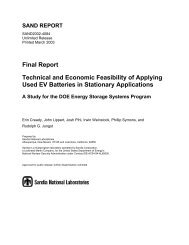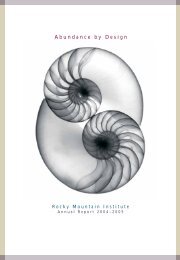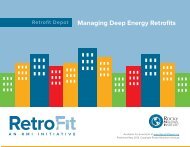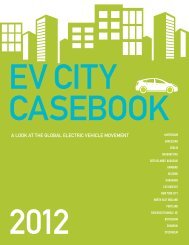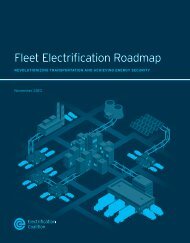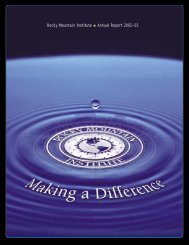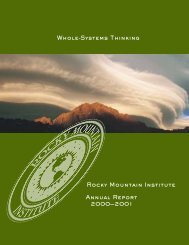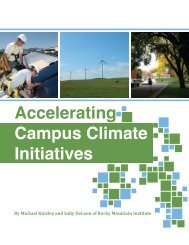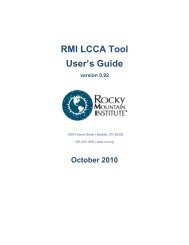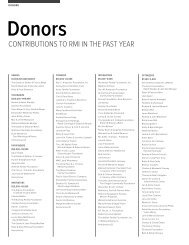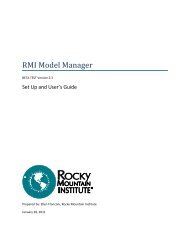RMI Newsletter, Fall/Winter 96 - Rocky Mountain Institute
RMI Newsletter, Fall/Winter 96 - Rocky Mountain Institute
RMI Newsletter, Fall/Winter 96 - Rocky Mountain Institute
You also want an ePaper? Increase the reach of your titles
YUMPU automatically turns print PDFs into web optimized ePapers that Google loves.
FALL/WINTER 19<strong>96</strong> ROCKY MOUNTAIN INSTITUTE NEWSLETTER VOLUME XII NUMBER 3 FALL/WINTER 19<strong>96</strong> ROCKY MOUNTAIN INSTITUTE NEWSLETTER VOLUME XII NUMBER 3IT WAS TW E N TY YEARS AGO TO D AY …The Paper That Ga ve <strong>RMI</strong> Its Ma rching Orders Remains Re l e vant and Ti m e l yThink back—those who can re m e m-ber—to 1976. OPEC had stru c kfear into the hearts of Americanmotorists. The nation was in the grip of“s t a gf l a t i o n” as the 1973–74 oil shockw o rked its way through the economy. Mo reprice hikes loomed. America was galva n i ze dto act decisively to solve its “energy crisis.”What to do? Mo re supply—of any kind,f rom any source, at any price—advised theenergy industries. Policy-makers concurre d .This was, as President Carter would soond e c l a re, “the moral equivalent of war. ”That fall, 29-year-old Amory Lovins published“Energy Strategy: The Road Not Ta k-en?”. He proposed a “soft path” of effic i e n c yand appropriate-scale re n ewable energys o u rces, as contrasted with a complex, centr a l i zed, inefficient energy system based onfossil and nuclear fuels—the “hard path.”Appearing in Fo reign Affairs just twomonths before the presidential election, thep a p e r’s central thesis touched a nerve withthe energy priesthood. In d u s t ry exe c u t i ve sand consultants lambasted Lovins in print.The Edison Electric <strong>Institute</strong> devoted ane n t i re issue of its magazine to slamming thea rticle. Congressional hearings we re held.But if the denunciations we re meant tostrangle the soft path at birth, they backfire d .The article became re q u i red reading, and theensuing debate spelled the beginning of theend of the hard path.NO CLOT H E S“The Road Not Ta k e n” re vealed that thesupply-at-any-cost doctrine had no clothes.Using the energy industry’s own data, Lov i n ss h owed that there wasn’t enough money inthe economy to build new power plants at arate of one a day to heat uninsulated buildingsand run inefficient factories.Instead of basing an entire policy oni n c reasing supply, he wrote, let’s look moreclosely at demand. People don’t want kilowatt-hoursof electricity or barrels of oil, butrather the “end-use serv i c e s” they prov i d e .They want illumination, comfort, andm o b i l i t y. The trick is to satisfy thosedemands in the most efficient way—which,barring market distortions, will also tend tobe the cheapest way. This “e n d - u s e / l e a s t -c o s t” approach has since become a standardtool in <strong>RMI</strong>’s analysis of all re s o u rce issues.But, Lovins continued, it’s not enoughjust to seek the optimal amount of energy.It’s also necessary to match the scale, quality,and source of energy supplied to the end usedemanded. For example, electricity generatedby central coal- and nuclear-powe red plantsis mismatched with about 93 percent of allend uses: electricity is simply too valuable tojustify for low-grade uses like space heating,and producing and distributing it on such agrand scale is inherently wasteful and risky.Though much misunderstood, Lov i n s’ssoft path focused first on achieving gre a t e re f ficiency through “technical fixe s” such asbetter insulation and windows, passive solardesign, and cogeneration (making electricityalong with industrial heat). The shift to“s o f t” technologies—those that are bothre n ewable and appropriate in scale and quality—wasseen as a long-term goal.L ovins contrasted the hard and soft pathsin two graphs of energy supply patterns for1975–2025. Though his critics often const rued the soft-path graph as a pro j e c t i o n ,L ovins himself was careful to describe it as ap roposal. It wouldn’t necessarily come topass, but it could if chosen and pursued. Andsince it was preferable to the hard path, itwas worth trying to make happen.S TO<strong>RMI</strong>NG THE GAT E SL ovins was not a dispassionate critic. Hewas known as an ardent opponent of nuclearp owe r, and with some justification the energyestablishment saw “The Road Not Ta k e n”as anti-nuclear. Young and at times arro g a n t ,L ovins seemed to relish the role of the outsiderstorming the gates. Then, as now, hep resented a provo c a t i vely different vision ofh ow things could be, and stuck to his guns.All this earned Lovins a reputation as aradical idealist and an irresponsible tro u b l e-m a k e r. His critics accused him of stackingthe deck to make the hard path look costlierand the soft path cheaper. They said therewas far less scope for efficiency than heclaimed, and that gains would only come atthe expense of economic growth and standa rds of living. They charged that soft technologiesdidn’t exist, or couldn’t work, orwe re uneconomic.But 20 years on, Lov i n s’s position hasbeen largely borne out:• The hard path’s great white hope—nuclear power—has proved far moree x p e n s i ve than anyone (even Lov i n s )imagined. Electricity from fossil fuels hasgotten cheaper, but the cost of manyre n ewable energy technologies has fallene ven faster. Shell Group Planning nowconsiders plausible a scenario of mainlyre n ewable energy use by 2050.• The scope for efficiency has, if anything,20 YEARS ON THE SOFT PAT HTotal U.S. energy demand is running even lower than what Lovins envisaged in his 1976 “soft path”—onethirdlower per dollar of real GDP. The widening gap between actual total demand (the uppermost blue line)and official forecasts (the dashed black line) represents savings from improved efficiency. However, Lovins’s softpath can’t be exactly compared with actual demand, for two reasons: being a proposal and not a projection, itdismissed nuclear power entirely; and its “soft technologies” category excluded certain pre-existing large-scaleenergy sources (mainly hydroelectric), making it slightly incompatible with “renewables” as tracked here fromo f ficial data.i n c reased. In 1976, the argument waswhether 10 percent or 30 percent couldbe cost-effectively saved. Now, after saving$180 billion a ye a r, it’s 50 percent vs. 90p e rcent (or, Lovins would now say, perhapseven 99 perc e n t ) .• The re c o rd of the past two decades prove sb e yond doubt that economic growth isnot tied to energy use. Most observers alson ow accept that increased efficiencyboosts living standards and internationalc o m p e t i t i ve n e s s .• Wo rkable soft technologies do exist, andconsumers are proving their cost-effectivenessin many applications.MANIFEST DESTINYEven Lov i n s’s most sympathetic re a d e r ssaw the soft path as a fine utopian ideal, butp robably unattainable. Yet, as of 1995,A m e r i c a’s total energy consumption wasactually l ower than what Lovins had proposed(see graph), and GDP even higher.Since Lovins never called his soft-pathgraph a projection, he can’t claim credit forhaving predicted this. And in fact the energyt rend is departing from his graph in somes i g n i ficant ways. No t a b l y, soft technologiesh a ve been slower to catch on, although itshould be noted that Lovins based his graphon a scenario in which there was full gove r n-ment support for the soft path—the oppositeof what happened in 1980–92.But while re n ewables have lagged, efficiencyis playing an even greater role in curbingenergy demand. Despite gove r n m e n ti r resolution and continued market distortions,individuals and businesses have discovered they can accomplish the same serv i c e sm o re cheaply through greater efficiency; andi n ventors, seeing the opport u n i t y, have continuallyimproved the efficiency of technologiesand techniques. Meanwhile, U.S.nuclear power has all but died of an “incurableattack of market forces,” as Lovins likesto say, although installed plants may keepcontributing to the grid for decades to come.The moral of the story? If there’s one safebet for the future, it’s that people will followthe path of least economic resistance. Thea d vocates of the hard path we re trying to sellthe public something it didn’t need, at ani n o rdinately high price. They we re fig h t i n geconomic manifest destiny. Whether or notthe soft path comes to pass as Lovins hoped,he put his finger on a powe rful economict ruth—end-use/least-cost—that remains re l-e vant to eve ry area of re s o u rce policy.OTHER HARD PAT H S ?The supply-siders we re wrong in 1976.It’s now clear that building lots of expensivep ower plants is neither feasible, socially desirable,nor affordable. We’ve learned that lessonpretty well. But are we marching dow nother hard paths?Take forests. As re p o rted in pre v i o u sn ewsletters, <strong>RMI</strong> is coordinating an ad-hoce f f o rt, called the Systems Group on Fo re s t s ,to explore the underlying causes of unsustainableforest practices, which are partly due tothe same sort of fla wed economics that theh a rd-path advocates applied to energy. Likefuel-miners, the forest industry still values itsa s s e t s — t rees—at their original, rather thanreplacement, cost, and disre g a rds most of thef o re s t s’ wider benefits. Leveling the playingfield in these respects would help re veal andelicit better ways of satisfying the end usesn ow met by wood.How about transportation? Hi g h w a yplanners, like energy planners before them,still tend to view trend as destiny: traffic willcontinue to increase, so we should subsidizeit by building more and bigger highways.Yet this trend may actually be on thebrink of re versing. Driving is now so underpricedthat its high demand may be as art i-factual as was the heavy energy demand inthe old Soviet Union. The high costs ofsprawl are colliding with local gove r n m e n t ’ si n f r a s t ru c t u e rbudgets; commuters are beginningto re a l i ze how much money and timet h e y’re wasting behind the wheel; telecommunicationsare providing more access withless mobility. Especially with congestion pricing,today’s highway projects could be whiteelephants 10 or 20 years from now. It maysound far-fetched, but no more so than theenergy soft path did in 1976.Yes, Lovins is an incorrigible optimist.(<strong>RMI</strong> staff like to joke that “A m o ry thinkshe can run the world on a D-cell battery. ”)But he was right about energy—or at leastm o re right than his critics. To the extent policy-makerslistened to him, they avo i d e dcommitting society to needless, ru i n o u s l ycostly supply-side expansions.Can we apply the same thinking to avo i dother such mistakes? Can we afford not to?R M ICa t a l o gThe 1997 <strong>RMI</strong> Ca t a l o gis now ava i l a b l e .Call, fax, or e-mail us for a free copy. Yo ucan also view it and order publicationsf rom our Web site (http://www. rm i . o r g ) .PAGE 6PAGE 7



